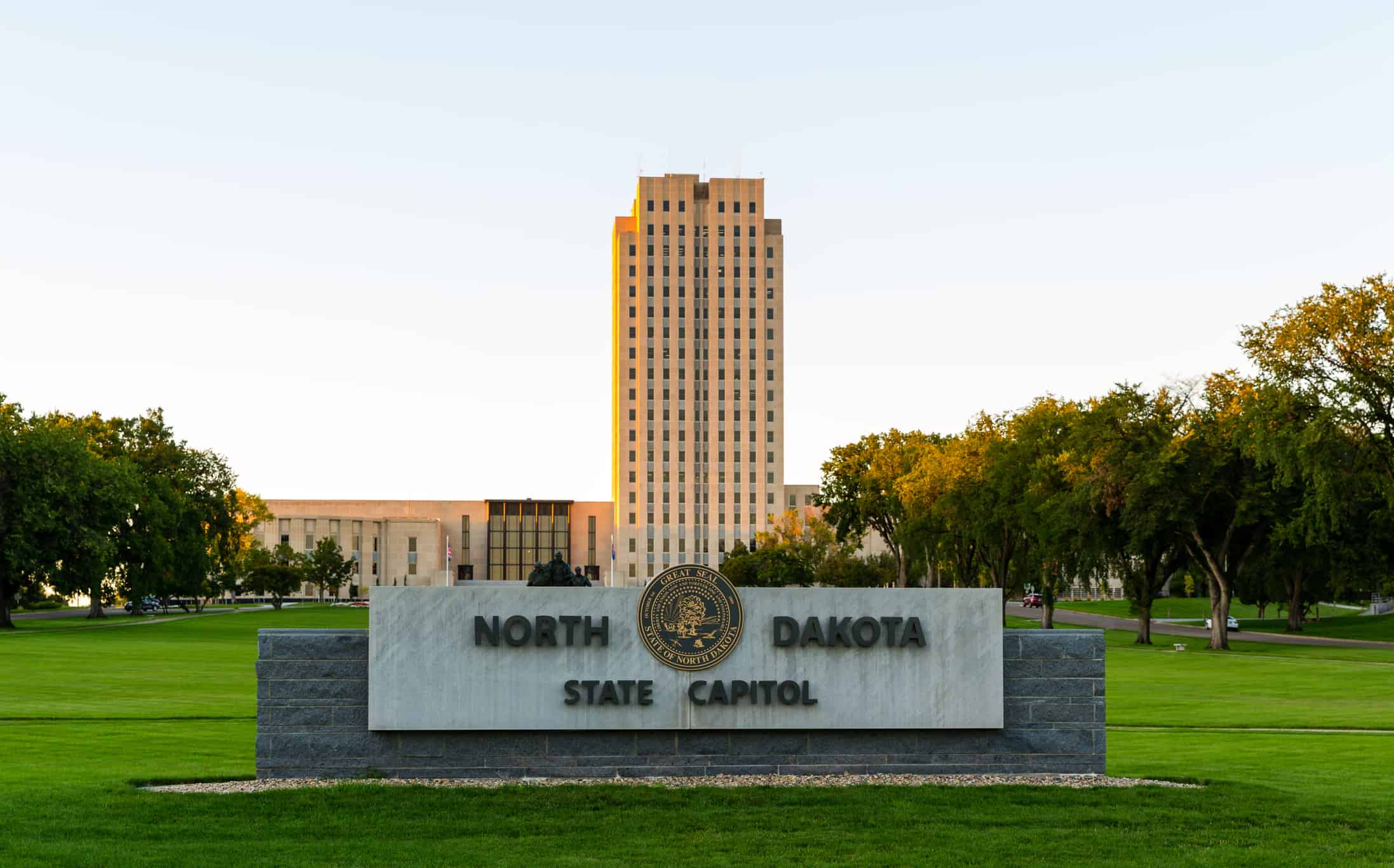North Dakota is known for its natural beauty and wide open spaces. The state is a great place to raise a family, with good schools, a low cost of living, and plenty of outdoor recreation areas. North Dakota has schools and summer camps for little ones to explore and learn about the beauty of the natural world. However, some of the schools in the state are struggling to meet academic performance guidelines. Here are the worst schools in North Dakota based on test scores, graduation rates, and overall academic performance.
Elementary Schools

©Ground Picture/Shutterstock.com
Warwick Elementary School in Warwick, North Dakota
Warwick Elementary School is underperforming academically and leaving students behind their peers. The school ranks 202 out of 202 schools, making it the worst elementary school in the state. In addition to test scores, the school's enrollment has seen a steady decline over the last few years and currently only has 86 students.
Edwin Loe Elementary School in New Town, North Dakota
Edwin Loe Elementary School has a student ratio of 13 to 1 with less than experienced teachers. Only 76% of teachers have more than three years of teaching experience. The school has seen a rise in enrollment and hopefully will also see a rise in test scores and student academic performance.
Wahpeton Elementary School in Wahpeton, North Dakota
Wahpeton Elementary School is a public elementary school with 424 students from first grade to fifth grade. The school has low overall academic performance, with test scores going down every year for the past ten years. The student-teacher ratio is 16 to 1, making it difficult for students to receive personalized help.
Madison Elementary School in Fargo, North Dakota
Madison Elementary School is a small elementary school in Fargo, North Dakota. The school serves a low-income community. It has seen test scores and enrollment plummet over the last five years. Despite the low test scores and academic performance, the school has received 4.3 stars out of five from parents of students. The school lags behind the rest of the district and the state averages.
Garden Valley Elementary School in Williston, North Dakota
Garden Valley Elementary School is a small rural school with a student-teacher ratio of 19 to 1. Each grade only has one class. The school community works together to keep students engaged. However, the test scores are far below the state average, and students are not getting the education they need.
High Schools

©LStockStudio/Shutterstock.com
Grafton High School in Grafton, North Dakota
Grafton High School has low test scores but still manages to have an 84% graduation rate. The school has few advanced courses, and students are performing far below the state average. The student-teacher ratio is 13 to 1, while the teachers all have more than three years of experience. The school received a low rating on Great Schools and appears to have low enrollment.
Garrison High School in Garrison, North Dakota
Garrison High School has low test scores and low enrollment. This school serves 150 students with a student-teacher ratio of 11 to 1. Despite the poor academic performance on tests, the school has a surprisingly high graduation rate of 97%. However, without advanced courses, students are not properly prepared for college.
New Town High School in New Town, North Dakota
New Town High School has below-average test scores, and students are not graduating with college prep or advanced courses. The graduation rate is 67%, but without any college prep courses, students are being pushed through the system without the skills they need. The student-teacher ratio is 11 to 1, and the majority of the teachers have more than three years of experience.
Dickinson High School in Dickenson, North Dakota
Dickinson High School students have consistently underperformed over the past three years, according to test scores. Despite the low test scores, the graduation rate is 93%. The school offers advanced courses, but test scores remain low. Great Schools ranked the schools low, but parents have given the school good reviews.
Williston High School in Williston, North Dakota
Williston High School serves 1,262 students in grades 9-12. The school has a graduation rate of 78% which is lower than the state average. In addition, the test scores are lower than the state average in reading, math, and science. The school does offer some advanced courses. However, the participation rate has been low. The student-teacher ratio is 16 to 1, which is higher than the state average.
Belfield High School in Belfield, North Dakota
Belfield High School is a small school serving students from seventh to twelfth grades. The school has low test scores in reading, math, and science. However, the graduation rate is 94%. The average ACT score is lower than the state average, and only 45% of students continue on to four-year universities. The student-teacher ratio is 12 to 1, with teachers who have less than three years of teaching experience.
Tioga High School in Tioga, North Dakota
Tioga High School serves 172 students from seventh to twelfth grades. The graduation rate is 80% which is lower than the state average of 87%. Only 44% of graduates go on to four-year institutions. The school’s test scores have remained lower than the state average. The student-teacher ratio is 12 to 1, which is the state average.
Powers Lake High School in Powers Lake, North Dakota
Powers Lake High School was given a low rating by Great Schools. The school has an 80% graduation rate, but students are graduating without any college preparation. The school has no advanced courses to educate students tha are going above and beyond. The student-teacher ratio is 10 to 1, but only 76% of teachers have more than three years of experience.
Lisbon High School in Lisbon, North Dakota
Lisbon High School has a graduation rate of 91%, but the test scores have continued to fall over the last few years. The school has few advanced courses and low participation. Great Schools rated the high school a 2 for college preparation and advanced course participation. However, the school is rated highly by former students for extracurriculars. The review is over ten years old, and no new reviews have been added.
Colleges

©Drazen Zigic/Shutterstock.com
Sitting Bull College in Fort Yates, North Dakota
Sitting Bull College is a small college in Fort Yates, North Dakota. The school is a remote public rural four years university. The small school has a 9% graduation rate in a four-year period.
Cankdeska Cikana College in Fort Totten, North Dakota
Cankdeska Cikana Community College is a two-year public school. The school offers undergraduate courses and programs. The graduation rate is low at 15%, with graduates making an annual salary of $21,100. The school offers twelve majors, with the most popular benign Liberal Arts and the Humanities.
Turtle Mountain Community College
Turtle Mountain Community College is a small private four-year university. The rural community college offers fourteen different majors, from liberal arts and humanities to education, engineering, and careers in the health industry. The school has a low graduation rate of 19%. The students that do graduate after ten years have an average salary of $24,400.
Nueta, Hidatsa, Sahnish NHS College(FormerlyFort Berthold Community College)
Nueta, Hidatsa, Sahnish NHS College is a small public two-year college offering undergraduate programs. The most popular programs are in the health industry. However, the school has a low graduation rate of 22%. The students that graduate after ten years make an annual income of $27,600.
Dakota College at Bottineau
Dakota College at Bottineau is a small two-year community college that has several undergraduate programs. The college is a remote rural college with on-campus housing to serve the extended community. The graduation rate is 25%. The school offers 22 different majors, with the most popular in Health and Liberal Arts and the Humanities. Students who graduate, on average, earn $40,800 ten years after graduation.
The image featured at the top of this post is ©iStock.com/4nadia.
